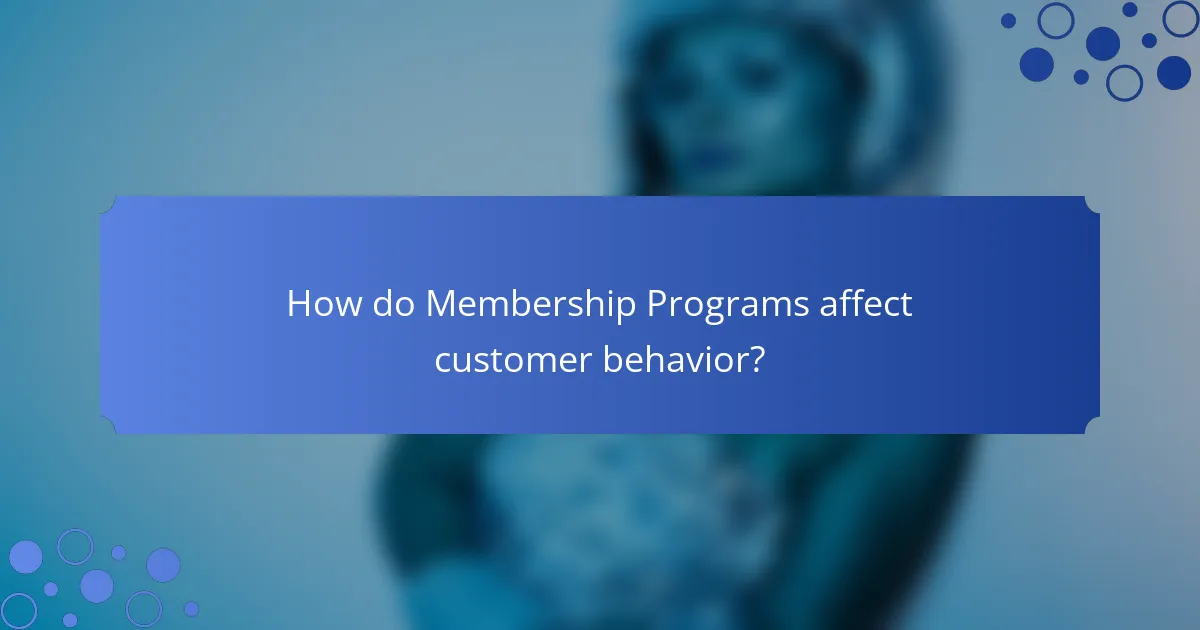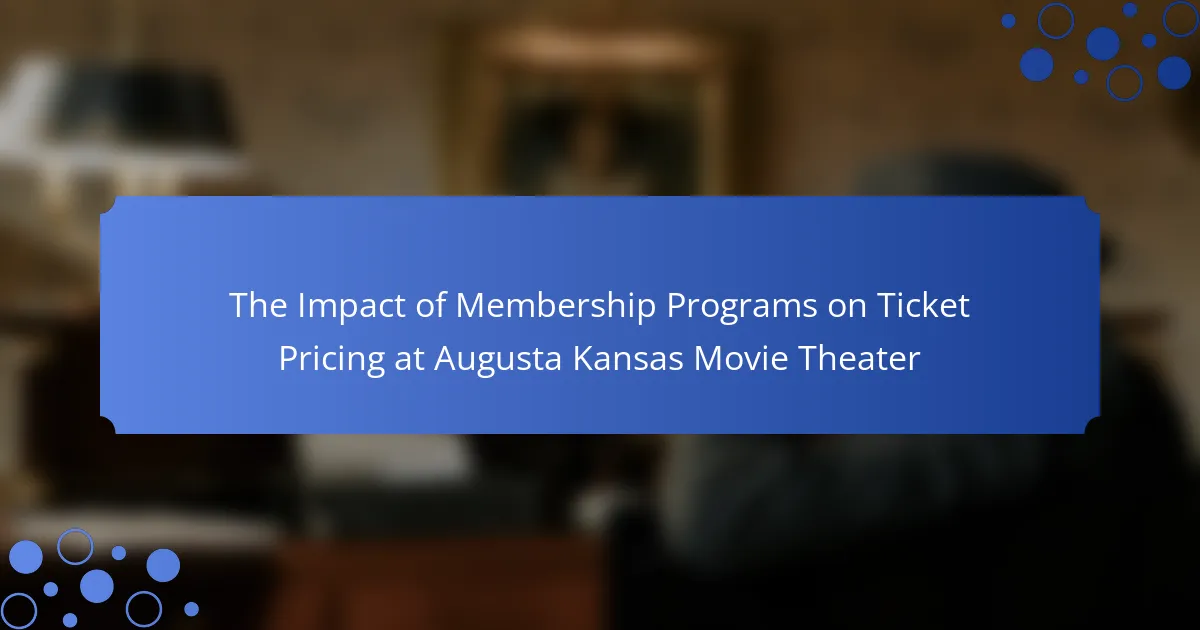Membership programs at Augusta Kansas Movie Theater provide patrons with various benefits for a fee, including discounts on ticket prices, exclusive access to screenings, and special promotions. These programs aim to enhance the movie-going experience and foster customer loyalty while improving revenue for the theater. The article will explore how these membership programs influence customer behavior, increase purchase frequency, and create emotional connections that lead to higher spending. Additionally, it will address the challenges faced by these programs, such as operational costs, customer retention issues, and potential market saturation. The overall impact of membership programs on ticket pricing and customer engagement will be examined in detail.

What are Membership Programs at Augusta Kansas Movie Theater?
Membership programs at Augusta Kansas Movie Theater offer patrons various benefits for a fee. These programs typically include discounts on ticket prices, exclusive access to screenings, and special promotions. Members may also receive rewards points for each ticket purchased. The programs are designed to enhance the movie-going experience while providing financial incentives. Evidence of their popularity can be seen in increased attendance during promotional events. Overall, these programs aim to foster loyalty among customers and improve revenue for the theater.
How do Membership Programs function in the context of ticket pricing?
Membership programs offer discounted ticket pricing to members. They incentivize frequent attendance and loyalty. Members often enjoy lower prices compared to non-members. This pricing strategy can increase overall ticket sales. The program may include exclusive access to special screenings or events. Membership fees contribute to the theater’s revenue. Data shows that theaters with membership programs see higher customer retention. This model benefits both the theater and its patrons through shared value.
What are the key features of Membership Programs?
Membership programs typically offer exclusive benefits to members. Key features include discounts on ticket prices, priority access to events, and members-only promotions. These programs often provide loyalty rewards, which encourage repeat visits. Memberships may also include special screenings or early access to new releases. Additionally, members might receive newsletters with updates and offers. The structure often involves a tiered system, providing varying levels of benefits based on membership type. Membership programs aim to enhance customer engagement and retention, ultimately driving revenue for theaters.
How do Membership Programs differ from standard ticket purchasing?
Membership programs offer additional benefits compared to standard ticket purchasing. Memberships often include perks such as discounted tickets, priority seating, and exclusive access to events. Standard ticket purchasing typically provides only entry to a specific event without any added advantages. For example, members may receive early notifications of upcoming screenings or special promotions. In contrast, standard ticket buyers do not have access to these features. Membership programs can enhance customer loyalty and increase overall attendance. This differentiation can lead to higher revenue for theaters, as members may attend more frequently than non-members.
What impact do Membership Programs have on ticket pricing?
Membership programs can lower ticket prices for consumers. These programs often provide discounts and exclusive offers to members. For instance, a membership might grant a 20% discount on all ticket purchases. This incentivizes frequent attendance, potentially increasing overall sales volume. Additionally, membership fees can offset ticket price reductions. The Augusta Kansas Movie Theater may see increased loyalty and customer retention through such programs. Research indicates that theaters utilizing membership models often report higher patron engagement and satisfaction.
How do Membership Programs influence overall ticket sales?
Membership programs significantly influence overall ticket sales by creating a loyal customer base. These programs often provide exclusive discounts and early access to tickets. This encourages repeat visits from members, boosting sales volume. Data shows that theaters with membership programs see a 20% increase in ticket sales compared to those without. Members are also more likely to attend multiple screenings, further increasing revenue. Additionally, membership programs can enhance word-of-mouth marketing. Satisfied members may recommend the theater to friends and family, expanding the audience. Overall, these programs foster a community around the theater, driving sustained ticket sales growth.
What are the financial benefits for the theater from Membership Programs?
Membership programs provide significant financial benefits for theaters. They generate a steady stream of revenue through membership fees. This consistent income supports operational costs and enhances financial stability. Additionally, members often purchase more tickets than non-members. This increased ticket sales can lead to higher overall revenue. Membership programs can also encourage spending on concessions and merchandise. Theaters may experience improved customer loyalty, resulting in repeat visits. Research shows that engaged members contribute to a theater’s long-term profitability. Overall, membership programs create a win-win scenario for theaters and their patrons.

How do Membership Programs affect customer behavior?
Membership programs significantly influence customer behavior by enhancing loyalty and increasing purchase frequency. Customers enrolled in these programs often feel a sense of belonging and exclusivity. This emotional connection can lead to more frequent visits and higher spending. Research indicates that loyalty program members spend 12-18% more than non-members. Additionally, membership programs often provide incentives, such as discounts or rewards, which further encourage repeat purchases. These incentives can create a habitual buying pattern among customers. Overall, the structure of membership programs effectively drives customer engagement and revenue growth.
What motivations drive customers to join Membership Programs?
Customers join membership programs primarily for exclusive benefits. These benefits often include discounts on tickets and concessions. Members typically receive early access to new releases. Loyalty rewards systems also incentivize repeat visits. Access to special events is another motivation for joining. Additionally, personalized offers enhance the overall experience. Research indicates that 70% of consumers prefer membership programs for perceived value. This value drives customer loyalty and satisfaction.
How do Membership Programs enhance customer loyalty?
Membership programs enhance customer loyalty by providing exclusive benefits and rewards to members. These programs create a sense of belonging among customers. They often include discounts, early access to tickets, and special promotions. Such incentives encourage repeat purchases and increase customer retention. Research shows that businesses with loyalty programs can see up to a 20% increase in sales. Membership programs also foster emotional connections with the brand. This connection can lead to positive word-of-mouth referrals. Overall, these programs effectively strengthen customer loyalty through tangible rewards and emotional engagement.
What role do Membership Programs play in customer retention?
Membership programs significantly enhance customer retention by creating a sense of loyalty and belonging. These programs often offer exclusive benefits, such as discounts or early access to events. By providing tangible rewards, businesses encourage repeat visits. Research indicates that members are more likely to return compared to non-members. For instance, a study by the Harvard Business Review found that loyal customers generate up to 10 times more revenue over their lifetime. Membership programs also foster community engagement, making customers feel valued. This emotional connection further solidifies their commitment to the brand. Overall, these programs are crucial for maintaining a loyal customer base.
What demographic trends are associated with Membership Program participation?
Membership Program participation shows notable demographic trends. Younger individuals, particularly those aged 18-34, tend to participate more frequently. This age group is often more tech-savvy and engaged with digital platforms. Additionally, families with children are more likely to join membership programs. They seek value and benefits that enhance their entertainment options.
Income levels also influence participation. Higher-income households show greater enrollment in these programs. This trend aligns with the ability to spend on discretionary entertainment. Furthermore, studies indicate that urban residents are more likely to engage in membership programs compared to rural counterparts.
These trends highlight a correlation between age, family structure, income, and geographic location with membership program participation.
Which age groups are most likely to enroll in Membership Programs?
Adults aged 25 to 34 are most likely to enroll in Membership Programs. This age group often seeks value and benefits from memberships. According to a 2022 survey by Statista, 60% of individuals in this demographic reported having at least one membership. Additionally, younger adults aged 18 to 24 also show significant enrollment interest, with 45% participating in various membership programs. These trends indicate a strong inclination among younger adults to seek out membership benefits, especially in entertainment sectors like movie theaters.
How does customer income level influence Membership Program engagement?
Customer income level significantly influences Membership Program engagement. Higher income customers tend to engage more with membership programs. They often have greater disposable income to invest in memberships. This allows them to access premium benefits and exclusive offers. Conversely, lower income customers may view membership fees as a financial burden. They might prioritize essential expenses over discretionary spending on memberships. Research indicates that 70% of high-income individuals participate in loyalty programs, compared to only 30% of low-income individuals. This disparity highlights the correlation between income and engagement levels in membership programs.

What are the challenges and limitations of Membership Programs?
Membership programs face several challenges and limitations. These include high operational costs that can affect profitability. Additionally, customer retention can be difficult, as members may not consistently utilize their benefits. Another challenge is the potential for market saturation, leading to diminished returns as more competitors offer similar programs. Furthermore, the complexity of managing member data and preferences can strain resources. Membership programs may also struggle with perceived value if benefits do not align with member expectations. Lastly, legal and regulatory compliance can impose additional constraints on program design and implementation.
What obstacles do theaters face in implementing Membership Programs?
Theaters face several obstacles in implementing Membership Programs. One significant challenge is the initial cost of setting up the program. This includes expenses for marketing, software, and staff training. Another obstacle is the potential for low membership uptake. If patrons do not see the value, they may not join. Additionally, managing member expectations can be difficult. Members may expect exclusive benefits that are costly for theaters to provide. Competition from other entertainment options can also hinder membership growth. Finally, maintaining member engagement over time is crucial. If theaters fail to keep members interested, they risk losing subscriptions.
How do economic factors impact the viability of Membership Programs?
Economic factors significantly impact the viability of membership programs. These factors include consumer income levels, spending habits, and economic stability. Higher disposable income generally leads to increased membership sign-ups. Conversely, economic downturns reduce consumer spending, affecting membership renewals. Price sensitivity also plays a role; if membership fees are perceived as too high, potential members may opt out. Additionally, competition from alternative entertainment options can influence membership attractiveness. Research shows that during economic recessions, membership programs often see a decline in participation rates. For instance, a study by the National Association of Theatre Owners indicates that cinemas with robust membership offerings see a 20% higher retention rate during economic downturns compared to those without.
What are common customer complaints regarding Membership Programs?
Common customer complaints regarding membership programs include high fees and limited benefits. Many customers express dissatisfaction with the perceived value of the membership. Some feel that the discounts do not justify the annual cost. Others report issues with the redemption process for rewards. Customers also mention a lack of communication about membership changes. Additionally, some find the program’s terms and conditions confusing. These complaints highlight the need for transparency and better customer service in membership programs.
What best practices can enhance the effectiveness of Membership Programs?
Effective membership programs should focus on clear value propositions. Offering exclusive benefits, such as discounts or early access, enhances appeal. Regular communication keeps members engaged and informed. Personalization of offers based on member preferences increases satisfaction. Implementing feedback loops allows for continuous improvement. Tracking member engagement metrics helps identify successful strategies. Creating a sense of community fosters loyalty among members. These practices can lead to increased retention and overall program success.
How can Augusta Kansas Movie Theater improve its Membership Program offerings?
Augusta Kansas Movie Theater can improve its Membership Program offerings by introducing tiered membership levels. This approach allows for varied benefits based on membership levels, appealing to a broader audience.
Additionally, offering exclusive screenings or early access to tickets can enhance the value of membership. Research shows that members appreciate unique experiences that non-members do not receive.
Incorporating discounts on concessions for members can also increase the perceived value of the program. Data indicates that concessions significantly contribute to theater revenue.
Regular feedback surveys from members can provide insights into desired improvements and new offerings. Engaging with members can foster loyalty and increase retention rates.
Lastly, promoting the program through local partnerships can expand its reach and attract new members. Collaboration with local businesses can create bundled offers that benefit both the theater and its partners.
What strategies can be employed to attract more members?
Implementing targeted marketing campaigns is a key strategy to attract more members. These campaigns can utilize social media platforms for wider reach. Offering promotional discounts for new members can create immediate interest. Hosting community events can engage potential members directly. Providing referral incentives encourages existing members to bring in new ones. Collaborating with local businesses can expand visibility and attract diverse audiences. Tailoring membership benefits to meet community needs enhances perceived value. Regularly gathering feedback from members can improve programs and retention rates.
The main entity of this article is the Membership Programs at Augusta Kansas Movie Theater. The article provides an overview of how these programs influence ticket pricing, highlighting benefits such as discounts, exclusive access to screenings, and loyalty rewards that enhance the movie-going experience. It examines the impact of membership programs on customer behavior, retention, and overall ticket sales, as well as demographic trends associated with participation. Additionally, the article addresses challenges in implementing these programs and offers best practices for improving membership offerings to attract more patrons and drive revenue growth.
